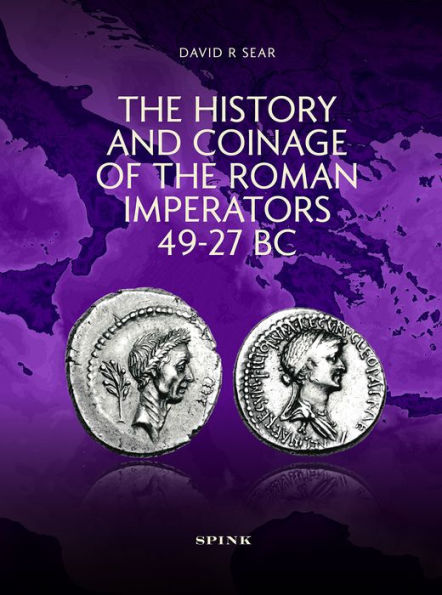The History and Coinage of the Roman Imperators 49-27 BC
The brief period covered by The History and Coinage of the Roman Imperators witnessed the violent transition of the Roman state from a republican constitution, presided over by the Senate, to a full military autocracy under the control of one man, the Emperor Augustus. In reality, the events of these years were merely the culmination of a movement which had been gathering strength over the preceding half century, since the rise of men such as Marius and Sulla. Caesar had put events into motion by his invasion of Italy and his challenge to Pompey’s dominant position in Roman politics. With his assassination on the Ides of March, 44 BC, Caesar's role was inherited by his youthful great-nephew Octavian who, against seemingly hopeless odds, succeeded in eliminating his rivals for supreme power, notably Mark Antony and his ambitious consort Cleopatra, Queen of Egypt.
This book traces in detail the unfolding of this drama. Each of its six chapters includes a comprehensive catalogue listing of all the relevant coin types and varieties, each with a full discussion of its significance in the interpretation of the events of the period. Information on the rarity of each type, including estimates of their value when first published in 2000, are presented in a separate table. The numerous, though less precisely understood, local coinages of the Imperatorial period are listed in an extensive appendix. Whilst providing a comprehensive numismatic reference work for the age of transition from Republic to Empire the author has also aimed to heighten the historian’s awareness of the vital role which may be played by the numismatic evidence in the detailed chronicling of events.
1137593918
This book traces in detail the unfolding of this drama. Each of its six chapters includes a comprehensive catalogue listing of all the relevant coin types and varieties, each with a full discussion of its significance in the interpretation of the events of the period. Information on the rarity of each type, including estimates of their value when first published in 2000, are presented in a separate table. The numerous, though less precisely understood, local coinages of the Imperatorial period are listed in an extensive appendix. Whilst providing a comprehensive numismatic reference work for the age of transition from Republic to Empire the author has also aimed to heighten the historian’s awareness of the vital role which may be played by the numismatic evidence in the detailed chronicling of events.
The History and Coinage of the Roman Imperators 49-27 BC
The brief period covered by The History and Coinage of the Roman Imperators witnessed the violent transition of the Roman state from a republican constitution, presided over by the Senate, to a full military autocracy under the control of one man, the Emperor Augustus. In reality, the events of these years were merely the culmination of a movement which had been gathering strength over the preceding half century, since the rise of men such as Marius and Sulla. Caesar had put events into motion by his invasion of Italy and his challenge to Pompey’s dominant position in Roman politics. With his assassination on the Ides of March, 44 BC, Caesar's role was inherited by his youthful great-nephew Octavian who, against seemingly hopeless odds, succeeded in eliminating his rivals for supreme power, notably Mark Antony and his ambitious consort Cleopatra, Queen of Egypt.
This book traces in detail the unfolding of this drama. Each of its six chapters includes a comprehensive catalogue listing of all the relevant coin types and varieties, each with a full discussion of its significance in the interpretation of the events of the period. Information on the rarity of each type, including estimates of their value when first published in 2000, are presented in a separate table. The numerous, though less precisely understood, local coinages of the Imperatorial period are listed in an extensive appendix. Whilst providing a comprehensive numismatic reference work for the age of transition from Republic to Empire the author has also aimed to heighten the historian’s awareness of the vital role which may be played by the numismatic evidence in the detailed chronicling of events.
This book traces in detail the unfolding of this drama. Each of its six chapters includes a comprehensive catalogue listing of all the relevant coin types and varieties, each with a full discussion of its significance in the interpretation of the events of the period. Information on the rarity of each type, including estimates of their value when first published in 2000, are presented in a separate table. The numerous, though less precisely understood, local coinages of the Imperatorial period are listed in an extensive appendix. Whilst providing a comprehensive numismatic reference work for the age of transition from Republic to Empire the author has also aimed to heighten the historian’s awareness of the vital role which may be played by the numismatic evidence in the detailed chronicling of events.
70.0
In Stock
5
1

The History and Coinage of the Roman Imperators 49-27 BC
392
The History and Coinage of the Roman Imperators 49-27 BC
392Hardcover
$70.00
70.0
In Stock

Product Details
| ISBN-13: | 9780907605980 |
|---|---|
| Publisher: | Pen and Sword |
| Publication date: | 07/08/2021 |
| Pages: | 392 |
| Product dimensions: | 7.40(w) x 9.70(h) x (d) |
About the Author
From the B&N Reads Blog
